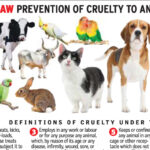The signing of the federal animal cruelty bill by President Trump marked a significant moment in the ongoing battle against animal cruelty in the United States. The legislation, officially known as the Preventing Animal Cruelty and Torture Act (PACT), received bipartisan support and was celebrated by various animal welfare organizations. Understanding the implications of this law is crucial for both advocates and citizens who care about animal rights and welfare.
The PACT law criminalizes a variety of forms of animal cruelty, specifically focusing on acts of intentional and malicious harm inflicted upon animals. Prior to this legislation, animal cruelty laws varied immensely from state to state, leading to a patchwork of regulations that often left significant gaps in protection. The PACT aims to unify these efforts at a federal level, establishing a clear and enforceable standard against egregious animal cruelty.
Animals are sentient beings capable of experiencing pain and distress. Therefore, the law’s scope includes various forms of mistreatment, such as dog fighting, cockfighting, and other forms of animal torture. It also includes provisions for investigating and prosecuting related crimes, thus empowering federal authorities to take action where state laws might falter.
But what does this law truly mean for the welfare of animals? Firstly, the federalization of animal cruelty offenses signifies a robust acknowledgment of the seriousness of animal abuse. This shift enables federal law enforcement agencies, like the FBI, to track animal cruelty cases, which are often indicators of broader social issues, including violence against humans. By taking these offenses seriously, the PACT positions itself within the larger context of public safety.
Moreover, one key aspect of the PACT is its ripple effect. With the establishment of federal penalties, states may feel encouraged to strengthen their own laws, thereby creating a more uniform approach to animal welfare. The law establishes felony offenses punishable by significant fines and imprisonment, underscoring the notion that cruelty towards animals is not just a minor infraction but a serious crime with dire consequences.
Despite the palpable enthusiasm among animal advocates, the PACT does have its limitations. It does not apply to all animals universally. For example, it primarily encompasses vertebrates while leaving many invertebrates, such as insects and aquatic creatures, without protection. This aspect raises concerns among animal rights groups, which argue for broader definitions of rights that encompass all sentient beings.
Furthermore, critics have pointed out that the law does not adequately address systemic issues that contribute to animal abuse. Issues such as poverty, lack of education about animal welfare, and inadequate resources for law enforcement agencies remain prevalent. Stray animals, for instance, continue to suffer from neglect and abuse. There’s an urgent need to couple legislative progress with community-based interventions that address the root causes of animal cruelty.
The law also does not tackle the associated industries that contribute to animal suffering. Factory farming and the fur trade exemplify systemic malpractices that the PACT does not directly confront. Advocates for animal rights are now tasked with the dual challenge of supporting the PACT while simultaneously urging for comprehensive reforms that hold industries accountable and promote ethical treatment of animals across the board.
Education plays a pivotal role in the fight against animal cruelty. The implementation of laws like the PACT should coincide with increased public awareness campaigns focused on humane treatment, responsible pet ownership, and the need for compassion towards all living creatures. Schools, local governments, and community organizations have significant roles in fostering a culture of empathy through education. Striving for public engagement can shift societal attitudes towards a more humane treatment of animals.
Moreover, the passage of the PACT has galvanized animal welfare advocates across the nation. It re-energizes the movement by serving as a poignant reminder of the progress that can be made when citizens come together to advocate for change. Grassroots organizations are mobilizing to strengthen their local laws, often inspired by the federal framework established by the law. This movement resonates particularly with younger generations, who are increasingly aware of and sensitive to issues of animal welfare and ethical treatment.
Looking ahead, it is imperative to monitor the law’s implementation and its efficacy in curbing animal cruelty. Advocates must remain vigilant to ensure that the frameworks developed under the PACT are enforced properly. Regular reviews and adaptations to laws may be necessary to ensure that they evolve alongside society’s understanding of animal rights and welfare.
In conclusion, the signing of the PACT represents a monumental stride towards combating animal cruelty and fostering a more humane society. Yet, the movement does not end here. The PACT must be seen as a catalyst for broader systemic changes that advocate for the rights of all animals, enforce harsher penalties for abusers, and cultivate educational initiatives to foster empathy. Every step forward, however small, contributes to an overarching quest for justice for our voiceless companions. The challenge now lies in sustaining this momentum and pushing for continuous improvement in our collective responsibility towards the welfare of all sentient beings.








